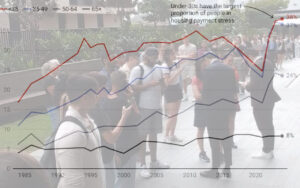Without a dramatic change of strategy, this election is now the Democrats’ to lose
Donald Trump is heading for defeat in this year’s election. I realise stating this is controversial — there has developed what I think is a misguided sense of inevitability about a Trump victory, especially on the radical right. When I said recently that I now believe Trump is going to lose, I encountered a flood of angry comments accusing me of needlessly blackpilling, ignoring polling, being contrarian, or just plain stupid.
I first expressed this view in opposition to my old nemesis, Academic Agent, who claims the election is a foregone conclusion, that Harris has “zero chance”, and that she has been appointed to play the role of a “jobber” (that’s pro-wrestling lingo for a wrestler whose job is to lose and make their opponents look strong.)

AA’s take on this is definitely the majority view. Trump has been handed win after win this year, from Biden’s shocking debate performance against him to his brush with death and triumphant recovery, giving us one of the greatest photos ever taken. With the nominee now almost certain to be Kamala Harris, some have taken this as confirmation that Trump really is the anointed one. Whatever chance old Joe had in a rematch with Trump, Kamala is electoral poison. While Biden could make the Democrats’ anti-white, radical left agenda palatable with his old-timey white guy shtick, Harris is the DEI regime’s real, ugly face. After all, even Democrat voters soundly rejected her.
This is a simple and intuitive, vibes-based approach to forecasting, and anyone could be forgiven for thinking fate is just on Trump’s side after the events in Pennsylvania, but I think the more I take a cold look at Trump’s prospects for this election, the more bleak they seem. I’m not saying he is certain to lose, and a lot can happen between now and November, but he is currently rated 1/2 with bookmakers, or about a 65% chance of winning. Presuming she is the unchallenged nominee for the Democrat party (not yet assured) I would flip it, and give those kind of odds, if not even shorter, to Harris. Thus, I think the current odds of 6/4 being offered on Harris represent a lot of value (not financial advice).
If we want to go from vibes to something tangible, we could look at polling. The problem though, is polling has proven to be a poor predictor of election outcomes in US presidential elections, especially this far out. It’s July. In July 1988, George H.W. Bush — who, like Harris, was then vice-president — trailed his Democrat opponent by 17 points. Bush not only won that year’s election, he won it handily: a smashing 426-111 victory in the electoral college vote.
At first, Trump was well ahead of Harris in national polling, but recently, Harris has made big gains, including in key swing states. A shift that dramatic in the space of a few days only underscores the fact that we can’t really expect these numbers to be the same four months from now, and that’s not even accounting for other issues like who’s answering the pollsters and who will actually turn up to vote.
No, polls won’t do. A lot of political scientists have tried to come up with a more reliable means of forecasting, to mixed success. From decades of testing, one method seems to stand out for its success: these are the “keys to the White House”, a method developed by American historian Allan Licthman.
Lichtman developed the keys in collaboration with a Soviet seismologist. Treating US elections with the same kind of systems-driven approach used to study earthquakes, the duo found a method of analysis which treats general elections as a referendum on the performance of the ruling party. Using the keys, Lichtman has correctly predicted the popular vote winner in every General Election from 1984 and 2012, correctly predicted Donald Trump’s win in 2016 (though he failed to win the popular vote), and Biden’s win in 2020. The system was also tested on past elections right back to the 1800s, and found to retrospectively predict them correctly, too. If there is a better system to predict elections, I haven’t found one.
With that said, I am not treating this method as decisive. Demographics are changing so rapidly that the US is hardly the same country as it was during most of the elections studied. But based on its past performance it is probably a good test of how voters will be feeling about the ruling party come November, and so seems like a good place to start.
The Keys to the White House in 2024
There are thirteen “keys” to the White House, which are a measure of the sentiment around the ruling party heading into the election. If a challenger candidate can turn a majority of the keys, there is likely to be a political earthquake, and an ousting of the ruling party, regardless of debate performances or the nature of their election campaign.
So, let’s see what the thirteen keys are, and how they are looking for this election cycle:
KEY 1 (Party Mandate): After the midterm elections, the incumbent party holds more seats in the U.S. House of Representatives than it did after the previous midterm elections.
2024 Verdict: False. The Democratic Party won fewer seats in the 2022 midterms than in 2018. However, this key has the least predictive value of all; the decline was slight (235 to 213 seats), and the Republicans performed well below the expected “Red Wave” in these elections.
One key for Trump.
KEY 2 (Contest): There is no serious contest for the incumbent-party nomination.
2024 Verdict: True. Biden didn’t face competition for the candidacy and then appointed Kamala as his successor, who has been endorsed by all the party big-wigs and seems to have the nomination secured. If she were to be challenged, or Democrat higher-ups were to organise a coup to replace her at the last minute with someone they consider more electable, this could be flipped, but right now it seems Harris is secure.
One key for Harris.
KEY 3 (Incumbency): The incumbent-party candidate is the sitting president.
2024 Verdict: False. Was true for Biden, not for Harris, though she represents the same administration.
Two keys for Trump
KEY 4 (Third-party): There is no significant third-party or independent campaign.
2024 Verdict: True. RFK jr. looks like one of the more credible threats to come from a third-party candidate for some time, but probably not enough to turn this key. Lichtman’s system rates them as a serious contender only if they poll over 10%. RFK jr. is unlikely to break this threshold.
Two keys for Harris.
KEY 5 (Short-term economy): The economy is not in recession during the election campaign.
2024 Verdict: True. The US Economy is experiencing good growth, and the Biden/Harris administration has invested heavily in the US economy in the last 4 years. A big economic shock between now and the election is unlikely.
However, although per-capita GDP is the easiest way to measure the short term health of an economy, it can be misleading, and since this is an election, voter perception matters more than real numbers. Lichtman’s model does not look at perception, only real growth, which seems like a potential oversight.
A recent study found that 3 in 5 Americans think the country is in recession, and most think it began last year. People also tend to misremember how good things were economically under previous administrations, and this seems to be happening with Trump now.
If most Americans think the country went into recession some time during the Biden/Harris administration after being handed a strong economy by Trump, can we really still call that a key for the Democrats? I think it will depend how voters feel by election time, so I’m going to leave this key neutral.
KEY 6 (Long-term economy): Real per-capita economic growth during the term equals or exceeds mean growth during the previous two terms.
2024 Verdict: True. Growth under Biden/Harris has been higher than the previous two administrations, and included a large bounce-back from the COVID slump.
Again, the same caveat applies regarding public perception. The American public think they’re a year into recession, mostly due to changes in the cost of living. Cost of living matters just as much as growth figures or earnings, since people judge their affluence by how much they can actually buy with what they earn. Still, the government seems to be getting inflation under control now, and on paper, Harris still has a good record to sell, so I’m going to say this key leans Democrat. Both economic keys could easily swing to Trump if the American economy goes into recession between now and the election.
(Tentatively) Three keys for Harris.
KEY 7 (Policy change): The incumbent administration effects major changes in national policy.
2024 Verdict: True. Biden’s greatest accomplishments are the massive investment programs, including a $1.9 trillion rescue package after COVID, a bipartisan infrastructure bill, and the CHIPS and Science Act which has directed more resources into American innovation.
Deindustrialisation was a major reason for the turn to Trump’s populism in the Rust Belt in 2016, but now Biden has doubled the amount of factory building in the United States and invested billions into American manufacturing. The US is also getting inflation under control, meaning there is a very formidable economic record for Harris to run on.
Four keys for Harris.
KEY 8 (Social unrest): There is no sustained social unrest during the term.
2024 Verdict: True. The pro-Palestine protests are the closest thing to serious social unrest, but they are nothing on the level of the summer of Floyd and not enough to turn this key.
Five keys for Harris.
KEY 9 (Scandal): The incumbent administration is untainted by major scandal.
2024 Verdict: True. As much as conservatives tried to make Hunter Biden the focus of a real scandal, it never landed, and Biden was a pretty controversy-free President.
Six keys for Harris.
KEY 10 (Foreign/military failure): The incumbent administration suffers no major failure in foreign or military affairs.
2024 Verdict: True. This one could be controversial, but none of the things that will be held up as Biden’s major foreign policy failures by Republicans really hold up. The withdrawal from Afghanistan was promised by Trump, and although some American soldiers were lost in the process, this hasn’t plagued the Biden administration. Although the Russian invasion of Ukraine and the breakout of war between Hamas and Gaza have caused problems for the Biden government, neither has been a disaster for him domestically. Russia has not yet achieved victory over the multinational coalition led by the US, and Americans are broadly in agreement with the current approach, or at least not opposed enough for it to be yet seen as a major failure.
Seven keys for Harris.
KEY 11 (Foreign/military success): The incumbent administration achieves a major success in foreign or military affairs.
2024 Verdict False. Just as there hasn’t been any massive failure, the Biden/Harris administration has no great foreign affairs story to brag about. Afghanistan could have been a success, if not for the messy withdrawal and loss of American lives on the way out. It seems unlikely the Israel/Palestine conflict will be resolved soon, and the hope of a surprise Ukrainian victory over Russia is even more unlikely.
Three keys for Trump.
KEY 12 (Incumbent charisma): The incumbent-party candidate is charismatic or a national hero.
2024 Verdict: False. This is reserved for the once in a generation candidate with huge cross-party appeal like FDR or Ronald Reagan, Harris certainly is not that.
Four keys for Trump.
KEY 13 (Challenger charisma): The challenging-party candidate is not charismatic or a national hero.
2024 Verdict: True. Trump has a cult-following and is a very charismatic figure, but he is also extremely divisive, and doesn’t have the ability to appeal to a broad base of support outside his party, as someone like Reagan or John F. Kennedy could.
Eight keys for Harris.
Final tally: Harris 8 – Trump 4
The keys are firmly in favour of the Democrats, suggesting voters are unlikely to be in the mood for the political earthquake of a democratic regime change. This methodology is mostly about the viability of the party, not the appeal of the candidate. But the keys would have been turned even more strongly in Biden’s favour if he was the incumbent, yet after his disastrous debate performance in early July, a consensus developed that his senility was so apparent that he would lose, regardless of his record governing. A similar argument is currently being made about Harris, she is just too unlikeable to win a national election. Is that true?
I would point to Hillary Clinton. In 2016, Clinton ranked as the presidential candidate with the second highest unfavourability rating ever, second only to Trump! Pollsters found ‘liar’ was the word most associated with Clinton in voters’ minds, and, she was shrouded in controversy over her deleted e-mails and, to a lesser extent, her primary contest with Bernie Sanders. Harris isn’t the most appealing politician, but I’m willing to bet she will be more popular than Clinton.
And despite the widespread dislike for Clinton, she still won the popular vote in 2016. What mattered was Clinton lost three key Rust Belt states to Trump that swung the election: Wisconsin, Michigan, and Pennsylvania. Trump’s margin of victory in those states? 79,316 votes. Trump won Pennsylvania by 46,435 votes, Wisconsin by 22,177 votes, and Michigan by 10,704 votes. These are tiny margins: to be precise, 0.057 of total voters cost Clinton the election. Now factor in eight years of demographic change and cultural leftism and ask yourself if Harris can gain this kind of margin on Hillary Clinton’
How (and who) Trump Won
In 2016, Trump won these Rust Belt states by challenging the Republican party from the outside and presenting as a populist. Trump actually won fewer White voters than Mitt Romney, but he won more of the White voters who mattered. There are a few interesting things about the key areas Trump flipped. For one, they are some of the Whitest counties in America:

Another interesting and anomalous thing about these swing states becomes apparent from looking at a map of voter attitudes in the US, which show that these states are some of the few in America where the majority voter attitude is ‘populist’ rather than some variant of conservative or liberal:

Many of these White, populist voters are disaffected Democrats who felt left behind by the country’s embrace of globalism and free trade. They chose Obama in 2008 and 2012, but switched to Trump in 2016 because they liked how he sounded on issues like immigration, protectionism and rebuilding American industry. After governing like Jeb Bush for four years, Trump gained more support from ideological conservatives, but he lost crucial support from the White, working-class moderates and populists whose votes are decisive in these states.

Instead of governing as a populist, Trump’s great legislative achievement was a Paul Ryan tax cut that favoured the rich. In the Rust Belt states in 2020, the trend was Trump losing a disproportionate share of lower and middle income earners, while either gaining or losing a smaller proportion of high income earners.

Non-college-educated White voters were critical to Trump’s victory in 2016, but in 2020 the Democrats made gains with this demographic, increasing their share of this vote from 28% to 33%.

A more relevant question than how much voters are going to like Kamala Harris is what Trump is going to do to win back the populist White voters he lost. Currently, the Harris campaign is doing more explicit outreach to White voters than Trump, who recently framed his opposition to mass-immigration as motivated by a desire to protect the jobs of Blacks and Hispanics. Part of a strategy, it seems, devised by Trump’s campaign manager Susie Wiles, who says they will compensate for losing White ‘Karens’ by winning ‘Jamal and Enrique’.
Trump had a chance to learn from his mistakes in 2020 and return to the populist platform that won him populist White voters in 2016. But Trump is proud of his record as President. At the RNC, speaker after speaker celebrated Trump’s tax cuts. There was very little mention of immigration — a South American immigrant addressed the crowd in Spanish and spoke about how illegal immigration was hurting legal immigrants like her. There is little mention either, of the vision of economic nationalism Trump pointed to in 2016. The focus instead is inflation — an always popular target for conservatives — gas prices, and oil. Speaker after speaker promised Trump would “unleash American energy” a return to the 2008 GOP “drill baby drill” platform.
Trump talked a good game about rebuilding American manufacturing in 2016, but he failed to deliver for working-class Whites in Rust Belt states. An economic study at the end of Trump’s term looked at well-being in five Midwestern swing states: Minnesota, Wisconsin, Iowa, Michigan, and Ohio. It found that among the counties that flipped from voting for Obama in 2008 and 2012 to voting for Trump in 2016, 61% were in economic decline. During Trump’s term, there was very modest growth in manufacturing jobs — about the same rate as Obama’s, and only enough to restore a fraction of the jobs lost in the prior decade.
In contrast, Biden has pumped billions into these Rust Belt states. Biden’s CHIPS and Science Act is bringing high-paying technology jobs into the American economy, which includes a focus in Georgia and Pennsylvania. In the year after passing the act, construction spending by US manufacturers more than doubled. The Rust Belt is becoming a center of electric vehicle production, with companies like Ford making big investments in EV battery production in these states. Biden’s Inflation Reduction Act pumped billions more into these states, giving generous subsidies and tax breaks to green energy manufacturers.

Manufacturing electric vehicles and solar panels isn’t how residents in these states might have imagined the return to industrial dominance when it was offered by Trump, but it has actually put these states at the center of an ecosystem of innovation after Trump offered them little for four years, instead focusing on another Reagan-era tax cut.
That was the whole story of Trump’s first term — making an appeal to White populism and economic nationalism, but handing policy over to the fiscal conservatives who populist voters despise. In fact, Trump’s ability to sell more of the same GOP policies with rhetorical populism has probably masked just how unpopular this agenda, and conservatism in general, is.
The fact is, the Republican Party has underperformed in every election since Trump won in 2016 by presenting as something other than a Republican. Since then, the Democrats have beaten the Republicans in the 2018, 2020, 2022 and 2023 elections. Democrats not losing ground in 2022 was especially significant, bucking the historical trend of midterm losses for the party in the White House. A big part of the reason Democrats were able to avoid the promised “red wave” in the 2022 midterms was the overturning of Roe vs. Wade in the same year, making abortion front and centre of national politics.
Abortion
Support for abortion is now at a record high among Americans: 69% now support legalising abortion for the first three months of pregnancy. This is not just a Democrat issue, when a referendum on “abortion rights” passed in Trump-voting Ohio in 2023, the New York Times reported that
Across the state, the margin of support for abortion rights was stronger than the margin of support for Mr. Biden three years ago. Among the Trump counties that voted for the amendment, the abortion rights vote was stronger where Mr. Trump won by smaller margins.
Elections in 2023 showed how the abortion issue could be decisive. Democrats in Virginia regained control of their state legislature with heavily abortion-focused campaigns. Red state Kentucky elected Democrat Andy Beshear over a Trump-endorsed candidate, helped by an attack on the state’s stringent abortion laws. Similar results occurred elsewhere. Politico concluded:
When the right to abortion is on the ballot, it wins. It wins in red states that voted for President Donald Trump. It wins in counties President Joe Biden lost by more than 20 points. It wins when popular Republican officials campaign for it and when they ignore it. And it wins even when the outcome has no immediate effect on abortion access.
The most telling example is the state of Michigan, an important swing state for the upcoming election. Richard Hanania:
The state voted for Trump in 2016, had a Republican governor until 2019, and a Republican legislature until last year’s midterms. Michigan now has Democratic women in the positions of governor, attorney general, secretary of state, and senate majority leader. To say that the Democrats in the state have run on abortion would be an understatement.
Gretchen Whitmer, the Democrat governor of Michigan, had been tipped as a potential late substitute for Biden if he decided to step down. Whitmer put abortion front and center of her campaigning:
At the Michigan State of the State, she did not treat abortion as Democrats often do, as if it’s slightly icky and private, damp and sad. She did not cordon it off in its own dolorous corner separate from all the rousing stuff about creating a mighty Michigan economy. Rather, she led with it, weaving it into a business-forward spiel called “Make It in Michigan,” suggesting that prioritizing abortion rights and LGBTQ+ protections would help bring businesses and expertise back to her former manufacturing state.
The result was historic support from women in Michigan, widening a gender gap between the parties that was already at a record in 2018.
The abortion issue especially activates college educated White women because it gets at a deep status anxiety — any woman is just one unwanted pregnancy away from joining the “poor Whites”, the most derided, low-status group in the country. These women will spearhead Harris’s campaign, and Harris being handed the torch has energised them in a way Biden didn’t. TikTok has been alight with educated White women and non-White zoomers giving “Momala” the meme energy Biden was lacking, and which Trump so successfully tapped into in 2016.

People writing off Kamala’s chances have said this is an astroturfed boost pushed by regime media, and Harris has little support on the ground. But just a week after being announced as the new Democrat candidate, she has raised $200 million, 66% of which is from first-time donors, and added over 170,000 volunteers to her campaign. This is quite a staggering boost from a change of candidate.
The election will be decided by who can get their demographics to turn out the strongest in key states, and Kamala will have an army of young volunteers to help with that. If Harris gets a strong turnout from Black and younger voters in high-density urban areas in swing states this would give her an advantage over Biden that could offset losing some of his White voters. Clinton lost White moderates to Trump, but the other factor in her defeat is she didn’t drive Black turnout as well as she could have, and that’s another area for Harris to make gains. And, for all the talk of Black voters rejecting Harris for not really being one of them, recent polling on Pennsylvania showed Harris with a slightly higher favourability among Black voters than Biden.
Part of why Harris got so much young support early in her campaign is her decision to immediately put abortion front and centre of her campaign. Trump, too, knows the abortion issue could be decisive, which is why he has emphasised that he does not support a national abortion ban, and stated his support for abortion in the case of “the exceptions”. At the RNC, Trump did something perhaps no other could have done: he got the Republican party to amend its platform to remove support for an abortion ban. But the Democrats look set to launch an offensive campaign which will portray Trump as being the gateway to an ultra-conservative takeover of America, paving the way for a national abortion ban.
This is why they have made Project 2025 the focus of their attacks, as it represents the kind of fear many otherwise Trump-voting women have about them accidentally greenlighting more radical conservatives. This may seem obviously misguided to people who follow this kind of thing (Trump has now disavowed Project 2025 multiple times), but it does seem to be resonating with low-information female voters. And this will only be exacerbated by Trump’s VP selection.
The Vance Problem
I liked the idea of Trump selecting JD Vance to be his running mate. Vance is, you might say, thematically pro-White, and points to a future where conservative politicians might be more willing to explicitly defend White people against blatant anti-White discrimination, as Vance has done. He also seems more likely than most to set about actually turning back the Civil Rights regime and delivering some conservative legislative accomplishments, which is obviously a big part of the reason liberals fear him.

Vance has already been identified by the social media mobs as an awkward chud whose attempts at being relatable to voters end in cringe. “JD Vance is weird” has become the popular meme among his enemies, and it looks like it might stick. This isn’t that bad, Vance could lean into being a nerdy policy wonk who is determined to dismantle the institutions which have kept his people down. But right now, he hasn’t got it. After his selection at the RNC, Vance polled as the most unpopular VP pick ever.
Vance is a much bigger problem for Trump on abortion. The media is going on the attack against Vance: for complaining about ‘childless cat-ladies’, for saying people with children should have more votes, and, for saying as recently as 2022 that he supports a national abortion ban and a federal response to women who travel across state lines for abortion.
These comments are going to be the focus of media and Democrat party attacks for the rest of the election cycle, and will block Trump’s attempts to win women with more liberal views on abortion. Little wonder then, that there are now stories abounding of Trump’s alleged regret over his selection.
Israel
One final point against Trump is his foreign policy. In theory, this should be an easy win for Trump: he didn’t start any new wars, and since he left office, conflict has flared in Gaza and Ukraine. Until recently, Trump intentionally stayed vague on policy as it concerned these conflicts.
Now though, Trump is taking a more hardline Zionist stance on Gaza, complaining that Kamala won’t let the Israelis “finish the job”. By the Democrats switching candidates, they have an opportunity to create some distance between Kamala and “genocide Joe” on Israel — Harris avoided attending Benjamin Netanyahu’s address to Congress, then came out and promised a ceasefire, peace deal, and an eventual two-state solution to end the conflict.
Events in Gaza caused a lot of interesting speculation about non-Whites, ideological leftists, and Muslims abandoning Biden, maybe even voting for Trump in protest. If the choice is now a Zionist promising a ceasefire and a Palestinian state versus a Zionist promising unconditional support for the Netanyahu government, there is no chance of this happening.
Harris’ position is the popular one: polling has consistently shown strong support for a ceasefire among Americans, including even a majority of Republicans. Only 13% hold the Trump position of opposing a ceasefire and allowing Israel to “finish the job”. It’s hard to know how much this issue is going to sway voters or boost turnout, but if it does, it won’t be in Trump’s favour.
Some more points in the Democrats’ favour
- A lot of the talk of Kamala’s unlikability with White voters in swing states will be offset by her VP pick. Currently, the favourites are former astronaut Mark Kelly and Pennsylvania governor Joshua Shapiro.
- Trump will likely lose the debates with Harris. Although he had some great moments against Hillary, polling on undecided voters showed they thought he lost every exchange. Harris performed reasonably well against Mike Pence in 2020, and Trump is not the man he was in 2016 or even 2020.
- In recent years MAGA has become more trashy, attracting a lot of low IQ, conspiratorial people. They are less likely to vote or volunteer for his campaign, and many Trump voters generally are demoralised by their belief that the 2020 election was rigged. If they are not demoralised, they are generally dismissive of Kamala’s chances in a way they weren’t of Hillary or Biden, as I have discovered discussing this. Contrast this with Democrat supporters, many of whom felt they were losing under Biden and believe Trump is going to try and end Democracy if he succeeds.
- Many Trump ‘24 maximalists believe the failed assassination attempt is a huge mark in Trump’s favour. I admit I got caught up in the spectacle of it at the time, and bought the consensus that this would hugely bolster Trump’s chances.In hindsight, I’m not sure it will have any effect at all. Polls conducted since haven’t shown Trump faring any better, and I feel like it will seem like ancient history by November. Trump wasn’t seriously injured, his re-appearance at the RNC after the event was lackluster, and the conservative subculture has already taken the energy out of it and made it uncool (their ability to do this to everything is quite something).Trump actually made a point of not using it to go on the offensive against the left, the media, or the deep state. Instead, he used the moment to push a message of ‘unity’, which translated to a 90 minute stump speech which has already been forgotten.
How Trump Can Still Win
By now, I think I’ve made it clear that the prospects for a Trump victory are very bleak, but that’s not to say he can’t win. There is still a long way to go until the election.
Given everything I have explained here about the demographics of the election, there is one clear path that stands out for Trump. It’s not complicated; in fact, it’s the same strategy that he used to win in 2016.
The election will be decided by who can get more of their demographic out to vote. Harris has recruited thousands of volunteers, raised hundreds of millions; she will win the Black vote. The Trump campaign can face up to this, drop the fantasy of a ‘Blexit’, find the populist White voters who are currently checked out, and focus on getting them to vote for Trump. Only 55% of non-college-graduate whites bothered to vote in 2020. If just 60% did, Trump would have won.

Recall how small the margins of victory were for Trump in swing-states in 2016. He had similarly small margins of defeat in 2020. Now consider that of the crucial non-college-educated White populists swinging between Democrat and Republican deciding these states, half are not even voting.
Brexit would not have passed without the Brexit campaign successfully targeting the biggest demographic of all — non-voters. These voters tend to be populist in their thinking, they don’t see either the “woke left” or the establishment right as representing their concerns. The Brexit campaign realised they could form a powerful protest vote bloc, and successfully won 2.8 million of them to their side.
The path to a Trump victory is staring Republicans in the face, but they would rather focus their energy on the fantasy of a multiracial coalition turning on the Democrats. Imagine if Republicans focused on beating Democrats at their own game, registered tens of thousands of non-college-educated Whites to vote in swing states, and even bussed them directly to the polls? This is an easy way to access tens of thousands of votes, and the only obstacle is the deep aversion to being seen to be courting White people.
We know what White populists want: immigration restriction, protectionism, affordable healthcare, a more fair redistribution of wealth; they still lean conservative in their social values but support more socialist economic policies. In short, they want nationalism. They dislike both parties. They liked when Trump seemed like an outsider challenging the GOP in 2016.

Trump could listen to his better instincts and campaign more like he did in 2016. The focus should be on crime and immigration, where Harris is weak, and on an economic nationalism that Trump dropped after becoming President. But most of these would-be voters aren’t very ideological. What matters is being a challenge to the elites, and the tribulations Trump has experienced over the past year have put him in a good position to embody that. JD Vance could come good as a voice of anger for a part of America that feels forgotten by the elites.
That is Trump’s path to victory in 2024 — not unity, but vengeance. And vengeance on behalf of America’s most reviled demographic: poor Whites. The last eight years make me believe it is unlikely the Trump campaign will embrace this. That’s why I believe this election is still the Democrats’ to lose.
This article was originally published by Keith Woods on Substack, and is republished by The Noticer with permission.
























